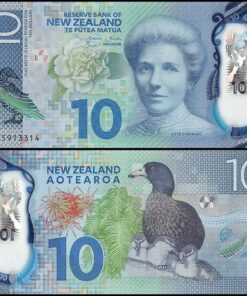New Zealand 20 Dollars Banknote, 2016, P-193a, UNC, Polymer
$135.00 – $260.00
Background of New Zealand Currency
Banknotes in New Zealand Currency
Since 1999, the New Zealand government has created plastic or polymer renditions of the New Zealand dollar. Because of this, banknotes are now more resistant to forgery. The lifetime of the banknotes has also been extended by the polymer composition. The expected lifespan of polymer banknotes is four times greater than that of ordinary linen or paper currency.
Polymer bills are safe to run through a washing machine without breaking. 2015 saw an update to the currency by the Reserve Bank of New Zealand (RBNZ), which added enhanced security measures and even more vivid colors.

Reserve Bank of New Zealand’s Impact on the NZD
New Zealand’s central bank is called the RBNZ. It is in charge of making fiscal and monetary policies that affect the value of New Zealand’s currency. In order to preserve price stability, set interest rates, and keep an eye on exchange rates, the RBNZ convenes monetary policy meetings seven times a year.
| Grades | Grade A, Grade B |
|---|---|
| Quantity | 500 Notes, 1000 Notes, 1000 Notes, 2500 Notes |
Be the first to review “New Zealand 20 Dollars Banknote, 2016, P-193a, UNC, Polymer” Cancel reply
Related products
New Zealand Dollars
New Zealand Dollars
New Zealand 50 Dollars Banknote, 2016, P-194a.1, UNC, Polymer
New Zealand Dollars
New Zealand 100 Dollars Banknote, 2016, P-195a, UNC, Polymer











Reviews
There are no reviews yet.